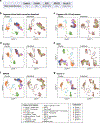Cumulus provides cloud-based data analysis for large-scale single-cell and single-nucleus RNA-seq
- PMID: 32719530
- PMCID: PMC7437817
- DOI: 10.1038/s41592-020-0905-x
Cumulus provides cloud-based data analysis for large-scale single-cell and single-nucleus RNA-seq
Abstract
Massively parallel single-cell and single-nucleus RNA sequencing has opened the way to systematic tissue atlases in health and disease, but as the scale of data generation is growing, so is the need for computational pipelines for scaled analysis. Here we developed Cumulus-a cloud-based framework for analyzing large-scale single-cell and single-nucleus RNA sequencing datasets. Cumulus combines the power of cloud computing with improvements in algorithm and implementation to achieve high scalability, low cost, user-friendliness and integrated support for a comprehensive set of features. We benchmark Cumulus on the Human Cell Atlas Census of Immune Cells dataset of bone marrow cells and show that it substantially improves efficiency over conventional frameworks, while maintaining or improving the quality of results, enabling large-scale studies.
Conflict of interest statement
Competing interests
AR is a founder of and equity holder in for Celsius Therapeutics, an SAB member of ThermoFisher Scientific, Neogene Therapeutics, and Syros Pharamceuticals, and Asimov, and an equity holder in Immunitas. NH is a founder and SAB member of Neon Therapeutics.
Figures









References
-
- Regev A et al. The human cell atlas white paper. arXiv:1810.05192 [q-bio] (2018).
-
- Yang A, Troup M, Lin P & Ho JWK Falco: a quick and flexible single-cell RNA-seq processing framework on the cloud. Bioinformatics 33, 767–769 (2017). - PubMed
Publication types
MeSH terms
Grants and funding
LinkOut - more resources
Full Text Sources
Other Literature Sources

